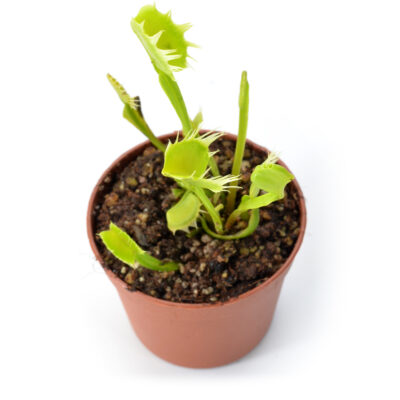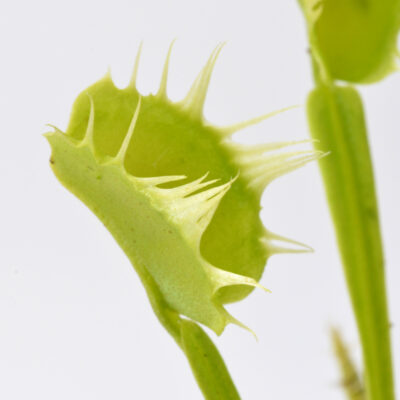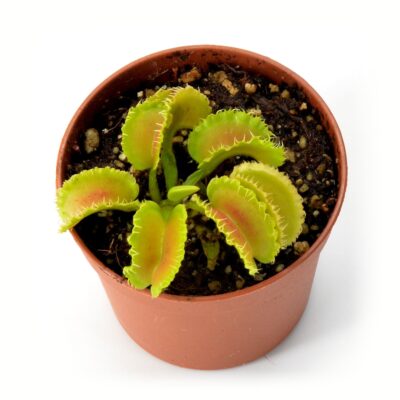-


6.00€ *Heliamphora minor, a carnivorous plant from Venezuelan Tepui, thrives in tropical highland conditions, but adapts well to most crops.
-


7.00€ *Pinguicula sp. Tolatongo: Mexican and tropical small, purplish plant with folded white-tipped lobes. Ideal for beginners. Prostrate shape.
-


0.40€ – 4.30€ *Blonde Sphagnum Peat is the substrate par excellence, used for growing our carnivorous plants, usually mixed 50/50 with perlite.
-


2.86€ – 7.92€ *Blond peat of sphagnum moss and perlite, mixed to 50%. The classic appropriate mix to make many carnivorous plant grow at their best, prepared by our staff.
-


15.00€ *Dionaea muscipula “Kim Il Sung”: Unique, aggressive form. Striking, distinctive appearance with irregular teeth and wavy forms. A must-have for fans!
-


10.00€ – 12.00€ *Dionaea muscipula ‘Alien’ is a giant prostrate plant with elongated, bean-shaped, and arched traps. One of the most notable features of this cultivar’s traps is their dentition, which vaguely resembles the teeth of a monster or an alien. The “teeth” of the traps are often fused together at the base, creating a jagged and irregular appearance.
-


12.00€ *Pinguicula laueana (Crimson Flower): Tropical carnivorous plant, dark green leaves, stunning red flowers. Great for beginners.
-


7.00€ *Drosera rotundifolia is easy to grow; it has green leaves, the trap is green but if it is exposed to full sun it turns slightly red.
-


2.75€ – 7.70€ *Agriperlite increases soil aeration for carnivorous plants. Mixed with sphagnum peat, it is an inert, expands 20 times and is microbiologically safe.
-


18.00€ *“Dionaea AR Werewolf”: upright clone with dark red color, narrow petiole, and stubby-toothed traps. Wavy and irregular. Striking yellow-orange leaf edge.
How to grow Venus flytraps (Dionaea Muscipula)?
Dionaea muscipula is a carnivorous plant belonging to the family Droseraceae (related to the genus Drosera) and native to the USA in a small coastal belt located between North and South Carolina. It lives in peat bogs, “flooded” peat plains constantly soaked with rainwater. The almost constant presence of water causes the soil to be anaerobic, or devoid of oxygen.
What type of sunlight is best for the growth and health of Venus flytraps (Dionaea Muscipula)?
Full sun all year! It is possible to shade slightly in the warmer summer months to avoid excessive temperatures that can stunt the plant’s growth.
Why a full sun?
- Energy issues. Capturing prey (i.e., closing the trap, starting the digestive process, and reopening the trap) requires a lot of energy from the plant. The energy comes indirectly from photosynthesis. So, increased light intensity = increased energy = increased catches!
- For habitat-related reasons. In peatlands, the number of plants able to grow is very limited, and these are mainly small shrubs or sporadic trees that can withstand acidic, nutrient-poor soil. A lack of large vegetation means that there is nothing to cast shadows on the plant, shielding it from direct sunlight.
How to water Venus fly traps?
3–4 cm of distilled water or rainwater is always present in the saucer. Alternatively, all waters that have extremely low mineral salt are suitable. For example, all condensation water (air conditioner, dehumidifier) conductivity of the water should have a value of fewer than 50 microsiemens.
Why?
Peatlands are ecosystems with an impermeable, mostly clay bottom, which does not allow rainwater to penetrate the lower layers. The result is permanently waterlogged soil that results from the condensation of atmospheric water vapor, which is naturally devoid of mineral salts.
Mineral salts, on the other hand, are commonly found in fresh water and in our aquifers and result from the dissolving of limestones that make up rocks and go into the waters of rivers and lakes. Dionaea muscipula has adapted to grow in an environment devoid of mineral salts derived from water, particularly carbonates that would, in the long run, raise the pH of the substrate, irreparably damaging the plant.
Dionaea likes stagnant water. 3–4 cm of distilled water in a container, even in the winter, even if it freezes. This is to faithfully imitate the naturally soupy environment in which they live.
Which substrate/soil should I use for Venus flytraps?
50% pure sphagnum peat, 50% perlite
Why?
Dionaea does not tolerate nutrients. We avoid pH-neutral or nitrogen-amended peats often found in acidophilic potting soils. Peat must be pure.
Perlite is an inert substrate that helps aerate the substrate. In nature, there is obviously none, but forced cultivation in small volumes (our pots) requires adaptation to increase the shelf life of the constantly wet substrate. CAUTION: Do not breathe in unprotected perlite dust; moisturize it properly before handling it; it is very fine dust and harmful to our lungs!
How to care for Dionaea muscipula in Winter?
You can keep the most cultivars outside, even during the coldest months!
Why?
It evolved to grow in a coastal area between North and South Carolina. So in a temperate climate with hot summers and cold winters, It also tolerates subzero temperatures for extended periods if, during the day, the substrate can thaw and the plant can absorb water properly.
What happens during the winter?
In late fall, the aerial part of the plant begins to blacken and eventually dry out. Dionaea actually conserves energy in an underground stem called the rhizome, which is white in color and lets most of the aerial part die as the cold weather arrives.
Don’t be concerned.
This is normal. The plant is doing well and should be hydrated with a few inches of water in the saucer less than in summer, in the same outdoor summer location. In spring, as temperatures rise and light hours increase, the aerial part will sprout again and the plant will begin to vegetate again.
What should you do in the spring?
In spring, temperatures increase, as do the hours of available light. These stimuli are perceived by the plant as the beginning of a new growing season.
Dionaea’s awakening is characterized by flower growth. If you are not interested in its pollination, we recommend severing it at a height of 2–3 cm from the base with a common pair of scissors. By severing the flower, all energy will be focused on leaf production, which can then develop to its full potential.
Check out our care guides for more information about carnivorous plants.


















































































